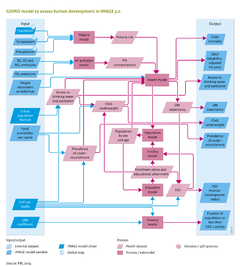Human development: Difference between revisions
Jump to navigation
Jump to search
No edit summary |
Oostenrijr (talk | contribs) No edit summary |
||
| (11 intermediate revisions by 3 users not shown) | |||
| Line 1: | Line 1: | ||
{{ComponentTemplate2 | {{ComponentTemplate2 | ||
|Application=OECD Environmental Outlook to 2050 (2012) project; Roads from Rio+20 (2012) project; | |Application=OECD Environmental Outlook to 2050 (2012) project; Roads from Rio+20 (2012) project; Beyond 2015 (2009) project; | ||
|IMAGEComponent=Drivers; Energy demand; Agricultural economy; Emissions; | |IMAGEComponent=Drivers; Energy demand; Agricultural economy; Emissions; Water | ||
|KeyReference=Hilderink and Lucas, 2008; PBL, 2012; | |Model-Database=GUAM model; World Bank database; FAOSTAT database; WHO database; | ||
|KeyReference=Hilderink and Lucas, 2008; PBL, 2012; PBL, 2009; | |||
|InputVar=Temperature - grid; Precipitation - grid; Food availability per capita; GINI coefficient; GDP per capita; People dependent on solid fuel; BC, OC and NOx emissions; SO2 emissions; Population - grid; Urban population fraction; | |InputVar=Temperature - grid; Precipitation - grid; Food availability per capita; GINI coefficient; GDP per capita; People dependent on solid fuel; BC, OC and NOx emissions; SO2 emissions; Population - grid; Urban population fraction; | ||
|OutputVar=Child mortality; Life expectancy; DALYs (disability-adjusted life years); Access to drinking water and sanitation; HDI (human development index); Child underweight; Prevalence of undernourishment; People living on less then USD 1.25 per day; | |OutputVar=Child mortality; Life expectancy; DALYs (disability-adjusted life years); Access to drinking water and sanitation; HDI (human development index); Child underweight; Prevalence of undernourishment; People living on less then USD 1.25 per day; | ||
| Line 9: | Line 10: | ||
On all scales from global UN processes to local initiatives, decision makers are concerned with improving the standard of living and human development. The IMAGE framework provides valuable insights into key environmental factors that affect human development, and how these impacts may be reduced by improving the natural environment. | On all scales from global UN processes to local initiatives, decision makers are concerned with improving the standard of living and human development. The IMAGE framework provides valuable insights into key environmental factors that affect human development, and how these impacts may be reduced by improving the natural environment. | ||
In the IMAGE framework, the Global Integrated Sustainability Model ([[GISMO model|GISMO]]) quantifies changes in human development, including access to | In the IMAGE framework, the Global Integrated Sustainability Model ([[GISMO model|GISMO]]) quantifies changes in human development, including access to food, water and energy, and the impact of economic, social and environmental changes (Hilderink and Lucas, 2008). The model includes the Human Development Index (HDI), population health measures (e.g. child mortality and life expectancy), and many indicators for the Millennium Development Goals ({{abbrTemplate|MDGs}}). | ||
Those parts of GISMO directly linked to other parts of IMAGE, are namely climate-related health risks, health problems related to urban and indoor air pollution, and the effects of malnutrition. | Those parts of GISMO directly linked to other parts of IMAGE, are namely climate-related health risks, health problems related to urban and indoor air pollution, and the effects of malnutrition. | ||
Revision as of 10:59, 1 July 2014
Parts of Human development
| Component is implemented in: |
|
| Related IMAGE components |
| Projects/Applications |
| Models/Databases |
| Key publications |
Key policy issues
- What are the key future trends in human development, such as those targeted by the Millennium Development Goals (MDGs)?
- How are changes in the global environment likely to affect human development?
- How is improved access to food, water and energy likely to contribute to human development?
